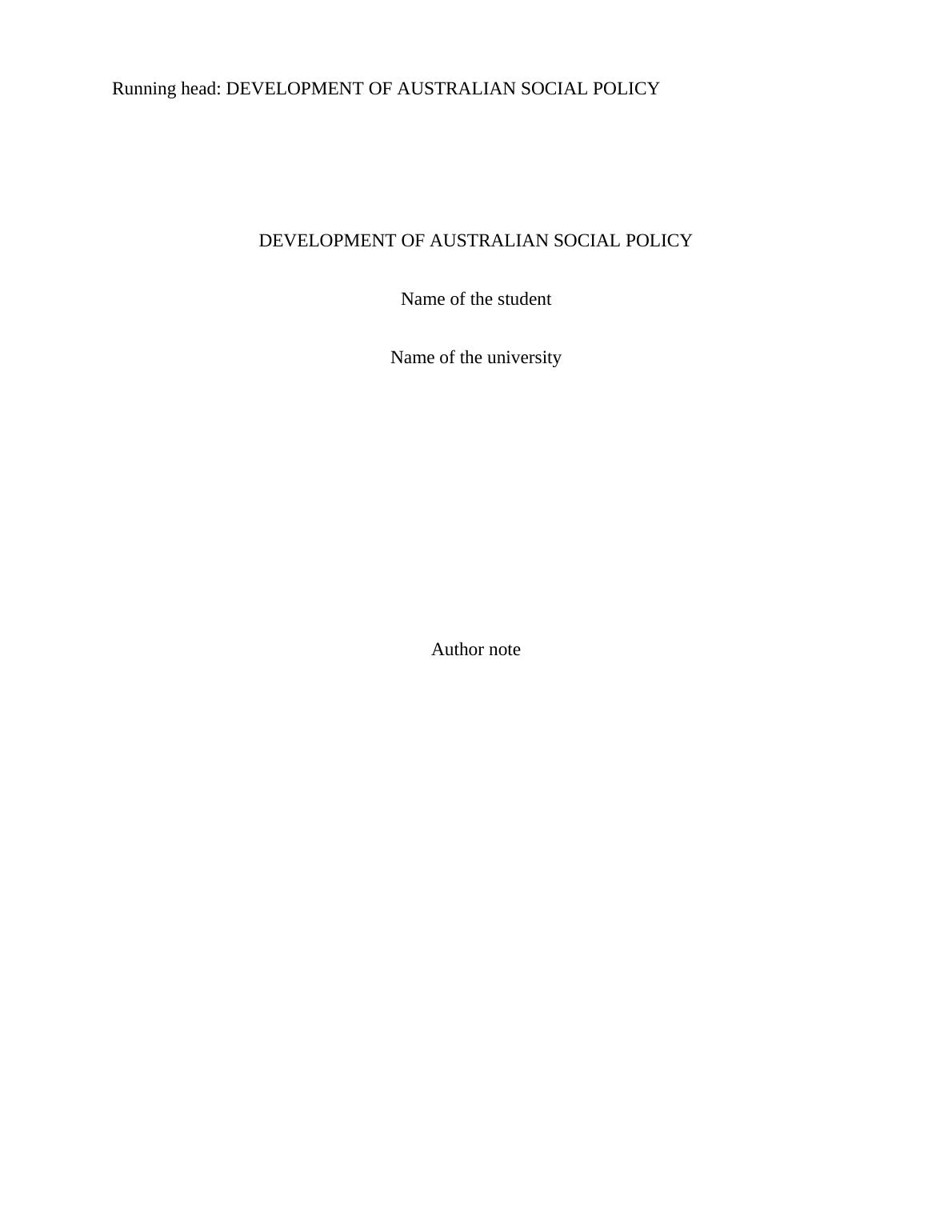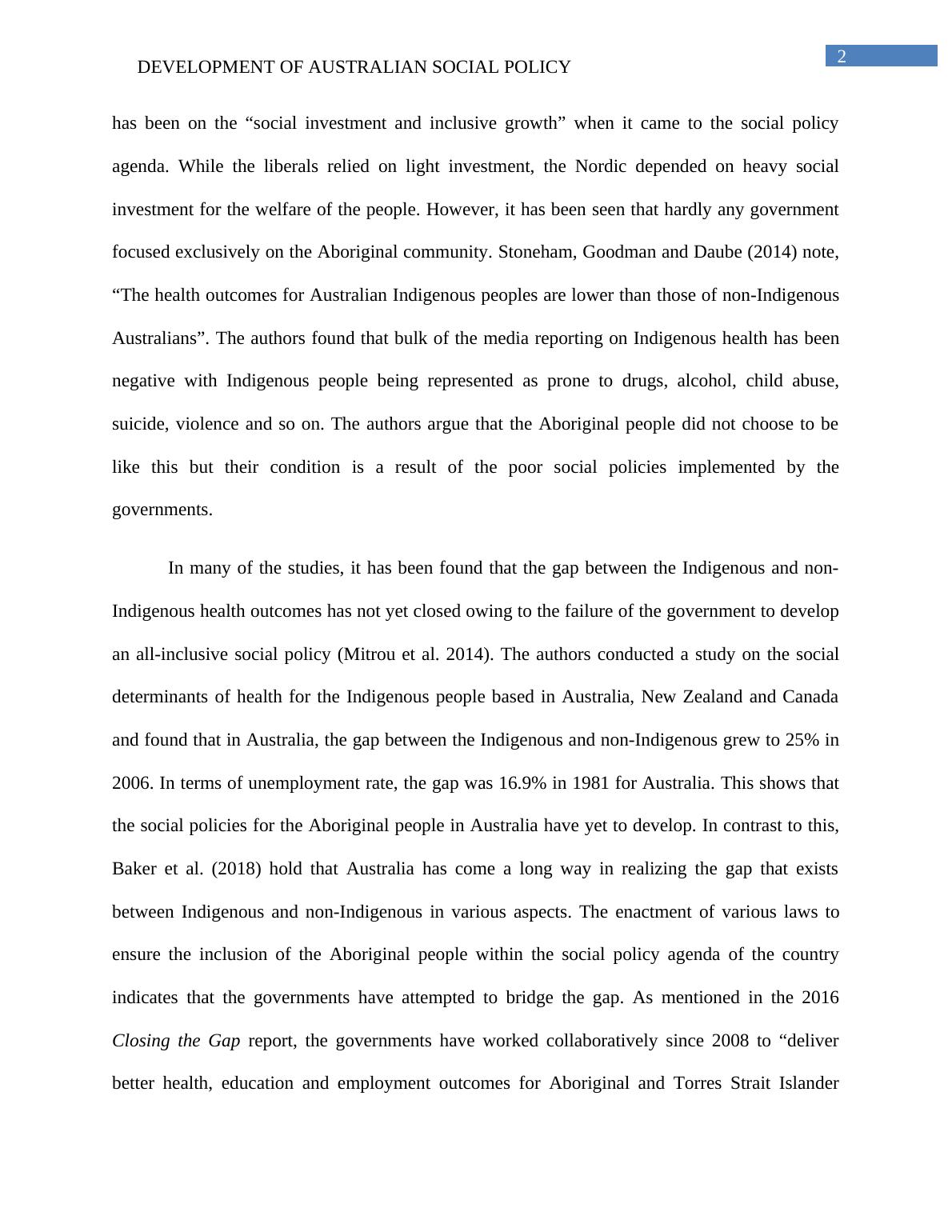Development of Australian Social Policy
Added on 2022-11-13
7 Pages1503 Words276 Views
Running head: DEVELOPMENT OF AUSTRALIAN SOCIAL POLICY
DEVELOPMENT OF AUSTRALIAN SOCIAL POLICY
Name of the student
Name of the university
Author note
DEVELOPMENT OF AUSTRALIAN SOCIAL POLICY
Name of the student
Name of the university
Author note

1
DEVELOPMENT OF AUSTRALIAN SOCIAL POLICY
Introduction
The assignment aims to conduct a literature research on the development of Australian
social policies and then analyze the findings. The social policies include policy on healthcare,
social welfare, child protection and education. In Australia, various departments look after the
introduction and implementation of the social policies. The social policies are public policies that
the Australian government uses for the welfare of the people and social protection. The main aim
of the essay is to argue that Australia needs to develop its social policies with an inclusion of all
communities.
Discussion
According to the Australian Institute of Family Studies, “social policy deals with the care
and development of individuals in the society according to a set of standards which the society
sets out to achieve” (Aifs.gov.au, 2019). At times, these standards are explained as the rights of
the individuals but mostly, these policies emerge owing to the competing political interests.
Several scholars argue that there has been remarkable shift in the policies concerning the society.
As Meagher and Goodwin (2015) argue in their book, the condition of social services in
Australia has seen a dramatic change in the recent decades wherein the governments have
extended the social provision without the expansion of the public sector. The authors have
looked at the provision of social policies from the point of view of marketisation where private
actors are given “public funds to deliver social services to citizens”. Deeming and Smyth (2014)
however, focus on the “social investment” of the government on the social policies especially
after the neoliberalism phase. They argue that the strategies for social investment differed during
the different regimes. They state that the focus of the government during the 2009 to 2014 period
DEVELOPMENT OF AUSTRALIAN SOCIAL POLICY
Introduction
The assignment aims to conduct a literature research on the development of Australian
social policies and then analyze the findings. The social policies include policy on healthcare,
social welfare, child protection and education. In Australia, various departments look after the
introduction and implementation of the social policies. The social policies are public policies that
the Australian government uses for the welfare of the people and social protection. The main aim
of the essay is to argue that Australia needs to develop its social policies with an inclusion of all
communities.
Discussion
According to the Australian Institute of Family Studies, “social policy deals with the care
and development of individuals in the society according to a set of standards which the society
sets out to achieve” (Aifs.gov.au, 2019). At times, these standards are explained as the rights of
the individuals but mostly, these policies emerge owing to the competing political interests.
Several scholars argue that there has been remarkable shift in the policies concerning the society.
As Meagher and Goodwin (2015) argue in their book, the condition of social services in
Australia has seen a dramatic change in the recent decades wherein the governments have
extended the social provision without the expansion of the public sector. The authors have
looked at the provision of social policies from the point of view of marketisation where private
actors are given “public funds to deliver social services to citizens”. Deeming and Smyth (2014)
however, focus on the “social investment” of the government on the social policies especially
after the neoliberalism phase. They argue that the strategies for social investment differed during
the different regimes. They state that the focus of the government during the 2009 to 2014 period

2
DEVELOPMENT OF AUSTRALIAN SOCIAL POLICY
has been on the “social investment and inclusive growth” when it came to the social policy
agenda. While the liberals relied on light investment, the Nordic depended on heavy social
investment for the welfare of the people. However, it has been seen that hardly any government
focused exclusively on the Aboriginal community. Stoneham, Goodman and Daube (2014) note,
“The health outcomes for Australian Indigenous peoples are lower than those of non-Indigenous
Australians”. The authors found that bulk of the media reporting on Indigenous health has been
negative with Indigenous people being represented as prone to drugs, alcohol, child abuse,
suicide, violence and so on. The authors argue that the Aboriginal people did not choose to be
like this but their condition is a result of the poor social policies implemented by the
governments.
In many of the studies, it has been found that the gap between the Indigenous and non-
Indigenous health outcomes has not yet closed owing to the failure of the government to develop
an all-inclusive social policy (Mitrou et al. 2014). The authors conducted a study on the social
determinants of health for the Indigenous people based in Australia, New Zealand and Canada
and found that in Australia, the gap between the Indigenous and non-Indigenous grew to 25% in
2006. In terms of unemployment rate, the gap was 16.9% in 1981 for Australia. This shows that
the social policies for the Aboriginal people in Australia have yet to develop. In contrast to this,
Baker et al. (2018) hold that Australia has come a long way in realizing the gap that exists
between Indigenous and non-Indigenous in various aspects. The enactment of various laws to
ensure the inclusion of the Aboriginal people within the social policy agenda of the country
indicates that the governments have attempted to bridge the gap. As mentioned in the 2016
Closing the Gap report, the governments have worked collaboratively since 2008 to “deliver
better health, education and employment outcomes for Aboriginal and Torres Strait Islander
DEVELOPMENT OF AUSTRALIAN SOCIAL POLICY
has been on the “social investment and inclusive growth” when it came to the social policy
agenda. While the liberals relied on light investment, the Nordic depended on heavy social
investment for the welfare of the people. However, it has been seen that hardly any government
focused exclusively on the Aboriginal community. Stoneham, Goodman and Daube (2014) note,
“The health outcomes for Australian Indigenous peoples are lower than those of non-Indigenous
Australians”. The authors found that bulk of the media reporting on Indigenous health has been
negative with Indigenous people being represented as prone to drugs, alcohol, child abuse,
suicide, violence and so on. The authors argue that the Aboriginal people did not choose to be
like this but their condition is a result of the poor social policies implemented by the
governments.
In many of the studies, it has been found that the gap between the Indigenous and non-
Indigenous health outcomes has not yet closed owing to the failure of the government to develop
an all-inclusive social policy (Mitrou et al. 2014). The authors conducted a study on the social
determinants of health for the Indigenous people based in Australia, New Zealand and Canada
and found that in Australia, the gap between the Indigenous and non-Indigenous grew to 25% in
2006. In terms of unemployment rate, the gap was 16.9% in 1981 for Australia. This shows that
the social policies for the Aboriginal people in Australia have yet to develop. In contrast to this,
Baker et al. (2018) hold that Australia has come a long way in realizing the gap that exists
between Indigenous and non-Indigenous in various aspects. The enactment of various laws to
ensure the inclusion of the Aboriginal people within the social policy agenda of the country
indicates that the governments have attempted to bridge the gap. As mentioned in the 2016
Closing the Gap report, the governments have worked collaboratively since 2008 to “deliver
better health, education and employment outcomes for Aboriginal and Torres Strait Islander

End of preview
Want to access all the pages? Upload your documents or become a member.
Related Documents
Indigenous Child Welfare | PPTlg...
|18
|1293
|12
Assignment on Indigenous Australianslg...
|7
|1588
|62
Australian Welfare System and Urban Developmentlg...
|7
|1441
|157
Close the Gap Policy in Australia: Challenges and Approacheslg...
|9
|2037
|245
Alternative Approaches to Improving Child and Family Welfarelg...
|9
|2847
|63
Population Education Development Associationlg...
|5
|1337
|11
